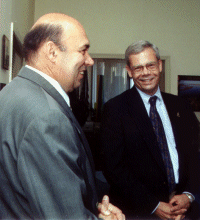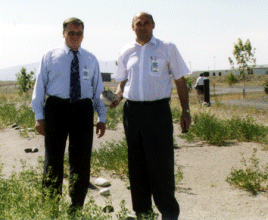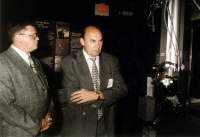Chornobyl Report
A biweekly update of Chornobyl support activities for July 17, 1998
 Slavutych Mayor Udovychenko and City of Richland, Washington, Mayor Larry Haler meet at a Richland Chamber of Commerce reception to welcome the visitors. |
 Chesnokov (left) and Mayor Udovychenko on a site tour of the HAMMER hazardous materials training facility in Richland. |
Slavutych dignitaries visit the United States
Arriving in the United States on the Fourth of July, Slavutych Mayor Volodymyr Udovychenko, and Slavutych Business Council Director Sergey Chesnokov saw first-hand how our nation celebrates its independence. They also learned during their weeklong visit how communities like Tri-Cities, Washington, have succeeded with economic development initiatives that helped to lessen their dependence on government-funded nuclear programs.
Udovychenko and Chesnokov spent the first two days in Washington, D.C. There, they met with Dr. Terry Lash, U.S. Department of Energy's director of the office of International Nuclear Safety and Cooperation, and other government and Washington, D.C. officials who support economic development activities in Slavutych. With plans to begin shutdown and deactivation of Chornobyl Unit 3 in the year 2000, Slavutych residents are seeking ways that their community, which is dependent almost solely on income generated by the plant, can continue to thrive.
 Chesnokov (left) and Mayor Udovychenko consider trying their hand at using a hot-cell manipulator on display at the Columbia River Exhibition of History, Science & Technology museum in Richland. |
Udovychenko and Chesnokov toured several local businesses and a new state-of-the-art hazardous materials training facility. The Hazardous Materials Management and Emergency Response (HAMMER) facility is used to train individuals involved with emergency operations, occupational safety and health, environmental and waste management, hazardous materials transportation, and decontamination. Many of the skills learned by workers who train at the HAMMER facility have direct application to work being performed at the Chornobyl Site.
EBPs maintain Shelter project momentum
Members of the Chornobyl Shelter Project Management Unit (PMU) Consultant team made considerable progress in recent weeks with the awarding of the project's first early biddable contract for civil engineering work. The contract for Package A was awarded on June 23 to a joint venture involving Morrison-Knudsen, British Nuclear Fuel Limited, and Ukraine's Interdisciplinary Scientific and Technical Center (ISTC), Ukraine Academy for Engineering Services (NIISK), and Kyiv Power Engineering Design Institute (KIEP). The contractor began mobilizing its team on July 6, with project offices being established in Kyiv and Cleveland, Ohio.
The PMU expects to have three additional contracts approved by the European Bank for Reconstruction and Development (EBRD) by month end. Package B for operations and monitoring services is awaiting notice of "non-objection" from EBRD, which will be followed immediately by contractor negotiations. Several technical and financial issues relating to Package C for emergency systems are being clarified, and the draft contract will be submitted to EBRD this week. Conclusions of the bidder evaluation group on Package D for fuel-containing material management will be sent to EBRD next week for review and approval by late July or early August.
An initial meeting between PMU officials and the Nuclear Regulatory Administration (NRA) was held in late June to discuss the objectives of both organizations relative to the Shelter Improvement Plan (SIP). As the primary Chornobyl Shelter regulator, the NRA will involve its staff in routine reviews of SIP activities.
Initial PMU staffing and mobilization activities are complete with 12 Bechtel, 7 Electricite' de France, and 6 Battelle employees on site. Offices and meeting rooms for the consultant team are being established in currently unused space at the Slavutych Laboratory.
Customs clears the way for more safety equipment
Three large shipments of industrial safety equipment to be used by workers at the Chornobyl Shelter cleared Ukrainian customs last week. Among the equipment delivered to the Shelter site were radiation-hardened cameras, video processing and photographic equipment, portable radios, and miscellaneous other safety devices. About 80 percent of the industrial safety equipment supplied by the United States has been released by the customs authority of Ukraine.
The June 26 edition of the Chornobyl Report reported that fall-protection devices and automated thermoluminescent dosimeters used to measure personnel radiation exposure had been released from customs. Unfortunately, Pacific Northwest National Laboratory (PNNL) subsequently learned that additional procedures are required before customs will release this equipment.
PNNL also is preparing to ship to Chornobyl a positive pressure containment portable enclosure and a local area radiation monitor to aid in worker radiation protection. Customs paperwork has been submitted, and PNNL is awaiting approval to ship these devices.
Slavutych Laboratory expands services
For many foreign nationals who visit Ukraine to assist with safety improvement initiatives, the language barrier may be the greatest challenge they encounter. Whether meeting on technical issues with Ukrainian counterparts at Chornobyl nuclear power plant (NPP), traveling in-country, or attempting to order a meal in a Ukrainian restaurant, non-Russian or Ukrainian speaking persons are at a disadvantage.
The Chornobyl Center's Slavutych Laboratory for International Research and Technology now offers a variety of document translation and interpretive services to individuals and firms involved in Chornobyl NPP activities. The service is being managed by PNNL's Contracts Office through Chornobyl Center's Ukraine contact, Mykola Kurilchik.
Chornobyl safety system passes factory test
The United States is providing Western technology to assist Ukraine with improving the safety of its operating reactors. Ukrainian President Leonid Kuchma recently visited the Westron facility in Kharkiv, Ukraine, to observe factory acceptance testing of a safety parameter display system (SPDS) for the operational Chornobyl Unit 3 nuclear power plant.
The system provides key safety information to the reactor operator in a manner that enables him or her to anticipate and avoid accidents or to respond quickly to minimize the consequences of an accident if one should occur. Safety parameter display systems became mandatory for commercial nuclear power plants in the United States following the Three Mile Island Unit 2 accident in 1979.
With the new system, Chornobyl NPP operators can receive updated safety information in three seconds. Previously, operators had to wait 10 minutes for the plant computer to provide the needed information.
The Chornobyl SPDS was designed by Westinghouse Electric and RDIPE, Russian designer of the Chornobyl type of reactor. The system was assembled and tested at the Westron facility in Kharkiv and will be installed at the Chornobyl NPP during a planned outage in late 1998.
The United States is providing similar systems to other nuclear power plants in Ukraine. Installation of an SPDS was recently completed at South Ukraine Unit 1. A similar prototype system is currently in operation at the Kursk Unit 2 plant in Russia. Factory acceptance testing also has been completed for systems to be installed at Russia's Khmelnytskyy Unit 1 and Zaporizhzhya Unit 5 this summer.
News items and comments can be directed to INSP Communications, (509) 372-6015, or e-mail susan.senner@pnl.gov.
See also the Biweekly Report Archives and Chornobyl Initiatives/General Information on Chornobyl